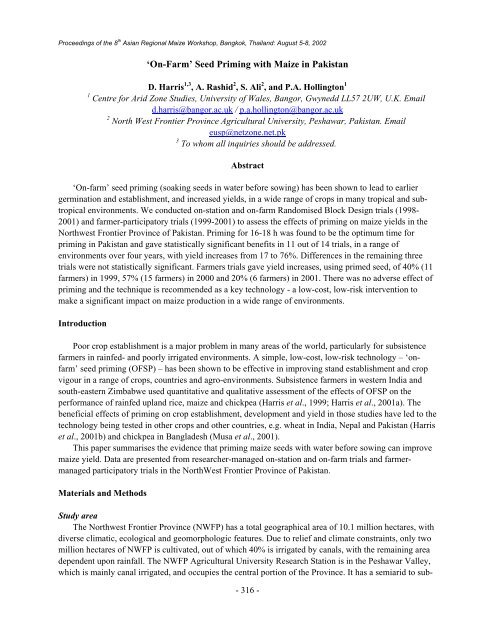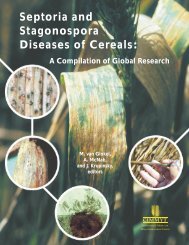Section 3 (Crop Management)
Section 3 (Crop Management)
Section 3 (Crop Management)
Create successful ePaper yourself
Turn your PDF publications into a flip-book with our unique Google optimized e-Paper software.
Proceedings of the 8 th Asian Regional Maize Workshop, Bangkok, Thailand: August 5-8, 2002<br />
‘On-Farm’ Seed Priming with Maize in Pakistan<br />
D. Harris 1,3 , A. Rashid 2 , S. Ali 2 , and P.A. Hollington 1<br />
1<br />
Centre for Arid Zone Studies, University of Wales, Bangor, Gwynedd LL57 2UW, U.K. Email<br />
d.harris@bangor.ac.uk / p.a.hollington@bangor.ac.uk<br />
2<br />
North West Frontier Province Agricultural University, Peshawar, Pakistan. Email<br />
eusp@netzone.net.pk<br />
3<br />
To whom all inquiries should be addressed.<br />
Abstract<br />
‘On-farm’ seed priming (soaking seeds in water before sowing) has been shown to lead to earlier<br />
germination and establishment, and increased yields, in a wide range of crops in many tropical and subtropical<br />
environments. We conducted on-station and on-farm Randomised Block Design trials (1998-<br />
2001) and farmer-participatory trials (1999-2001) to assess the effects of priming on maize yields in the<br />
Northwest Frontier Province of Pakistan. Priming for 16-18 h was found to be the optimum time for<br />
priming in Pakistan and gave statistically significant benefits in 11 out of 14 trials, in a range of<br />
environments over four years, with yield increases from 17 to 76%. Differences in the remaining three<br />
trials were not statistically significant. Farmers trials gave yield increases, using primed seed, of 40% (11<br />
farmers) in 1999, 57% (15 farmers) in 2000 and 20% (6 farmers) in 2001. There was no adverse effect of<br />
priming and the technique is recommended as a key technology - a low-cost, low-risk intervention to<br />
make a significant impact on maize production in a wide range of environments.<br />
Introduction<br />
Poor crop establishment is a major problem in many areas of the world, particularly for subsistence<br />
farmers in rainfed- and poorly irrigated environments. A simple, low-cost, low-risk technology – ‘onfarm’<br />
seed priming (OFSP) – has been shown to be effective in improving stand establishment and crop<br />
vigour in a range of crops, countries and agro-environments. Subsistence farmers in western India and<br />
south-eastern Zimbabwe used quantitative and qualitative assessment of the effects of OFSP on the<br />
performance of rainfed upland rice, maize and chickpea (Harris et al., 1999; Harris et al., 2001a). The<br />
beneficial effects of priming on crop establishment, development and yield in those studies have led to the<br />
technology being tested in other crops and other countries, e.g. wheat in India, Nepal and Pakistan (Harris<br />
et al., 2001b) and chickpea in Bangladesh (Musa et al., 2001).<br />
This paper summarises the evidence that priming maize seeds with water before sowing can improve<br />
maize yield. Data are presented from researcher-managed on-station and on-farm trials and farmermanaged<br />
participatory trials in the NorthWest Frontier Province of Pakistan.<br />
Materials and Methods<br />
Study area<br />
The Northwest Frontier Province (NWFP) has a total geographical area of 10.1 million hectares, with<br />
diverse climatic, ecological and geomorphologic features. Due to relief and climate constraints, only two<br />
million hectares of NWFP is cultivated, out of which 40% is irrigated by canals, with the remaining area<br />
dependent upon rainfall. The NWFP Agricultural University Research Station is in the Peshawar Valley,<br />
which is mainly canal irrigated, and occupies the central portion of the Province. It has a semiarid to sub-<br />
- 316 -









